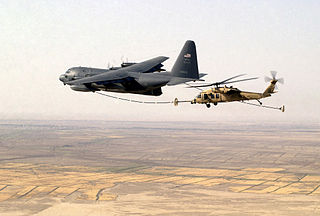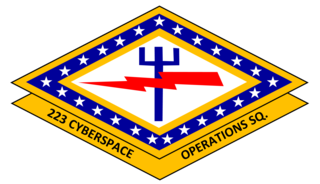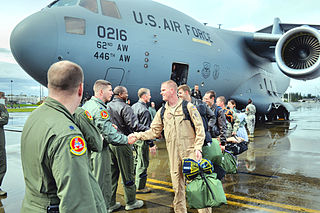
The 67th Cyberspace Operations Group is a unit of the 67th Cyberspace Wing. Headquartered on Kelly Field Annex's Security Hill, the group is an Air Force information operations unit.

The 18th Intelligence Squadron was a space intelligence organization of the United States Air Force, located at Wright-Patterson Air Force Base, Ohio.

The 39th Information Operations Squadron is an information operations and cyber Formal Training Unit, part of the 318th Cyberspace Operations Group.

The 815th Airlift Squadron is a flying unit of the United States Air Force assigned to the Air Force Reserve Command and part of the 403d Wing at Keesler Air Force Base, Mississippi. It operates Lockheed C-130J Hercules aircraft providing global airlift.

The 68th Fighter Squadron was one of the longest-serving fighter squadrons in U.S. Air Force history, remaining active almost continually for 60 years. Known as the "Lightning Lancers", on the morning of 27 June 1950 pilots of the 68th Fighter-All Weather Squadron flying the North American F-82 Twin Mustang made history by achieving the first aerial kill of the Korean War.

The 39th Rescue Squadron is an Air Force Reserve Command unit of the 920th Rescue Wing at Patrick Space Force Base, Florida. Until December 2019, it operated the Lockheed HC-130P/N Combat King aircraft conducting search and rescue and combat search and rescue/personnel recovery missions. The squadron is currently transitioning to the Lockheed Martin HC-130J Combat King II aircraft, which will provide significant increases in the squadron's capabilities. An Air Force Reserve Command unit, the 39th Rescue Squadron is operationally-gained by the Air Combat Command (ACC) upon mobilization.

The 315th Air Division is an inactive United States Air Force unit. Its last assignment was with Pacific Air Forces, based at Tachikawa Air Base, Japan. It was inactivated in April 1969.

The 475th Air Base Wing is an inactive United States Air Force unit. Its last duty station was at Yokota Air Base, Japan, where it was inactivated on 1 April 1992.

The 63rd Air Refueling Squadron, sometimes written as 63d Air Refueling Squadron, is a United States Air Force Reserve squadron, assigned to the 927th Operations Group at MacDill Air Force Base, Florida. It is a reserve associate of the active duty 91st Air Refueling Squadron. The squadron operates the KC-135 Stratotanker aircraft conducting air refueling missions.

The 39th Flying Training Squadron is part of the 340th Flying Training Group and is the reserve associate to the 12th Flying Training Wing based at Randolph Air Force Base, Texas.

The 92d Cyberspace Operations Squadron is a United States Air Force unit.

The United States Air Force's 223rd Cyberspace Operations Squadron is an Air National Guard Cyberspace Operations unit located at Little Rock Air Force Base, Arkansas.

The United States Air Force's 691st Intelligence, Surveillance and Reconnaissance Group is an intelligence unit located at Fort George G. Meade, Maryland.

The United States Air Force's 543d Intelligence, Surveillance and Reconnaissance Group is an intelligence unit located at Joint Base San Antonio, Texas. It has been located there since 1997, when it was activated as the 543d Intelligence Group. It focuses on cryptologic operations and signals intelligence.

The United States Air Force's 7th Intelligence Squadron is an intelligence unit located at Fort George G. Meade, Maryland. The squadron, as the 7th Radio Squadron, Mobile, provided intelligence for American forces in New Guinea and the Philippines during World War II. As the 302d Radio Squadron, Mobile, it was active in the organized Reserve from 1948 to 1949.

The 318th Cyberspace Operations Group is a United States Air Force information operations unit located at Joint Base San Antonio, Texas. The group was first activated during World War II as the 8th Photographic Reconnaissance Group. After training in the United States, the unit moved to the China-Burma-India Theater and engaged in hostilities until the end of the war. It returned to the United States in November 1945, and was inactivated at the port of embarkation.

The United States Air Force's 301st Intelligence Squadron is an intelligence unit located at Joint Base Elmendorf-Richardson, Alaska.

The 817th Expeditionary Airlift Squadron is a provisional United States Air Force unit, assigned to Air Mobility Command to activate or inactivate as needed. It engaged in combat operations in Southwest Asia.

The 67th Cyberspace Wing is a United States Air Force wing stationed at Lackland Air Force Base, Texas. It was activated in October 1993 as a military intelligence unit and is assigned to the Sixteenth Air Force.

The United States Air Force's 43d Intelligence Squadron is an intelligence unit located at Cannon Air Force Base, New Mexico. It provides intelligence support to Air Force Special Operations Command.
























